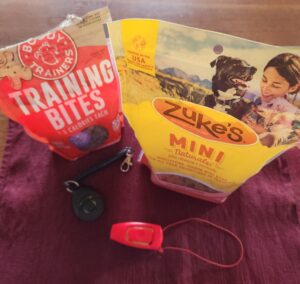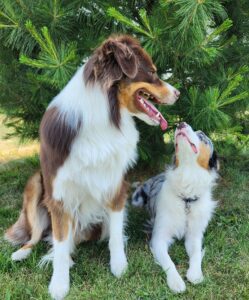The Handler’s Influence on a Dog’s Behavior
A handler plays a crucial role in shaping a service dog’s behavior, either by setting them up for success or inadvertently making situations more difficult. The key to a great service dog lies in the quality of the partnership between dog and handler. Every moment is a learning opportunity for the dog, and it’s up to the handler to ensure that the lessons taught are constructive and beneficial.
Navigating a Busy Environment
Imagine a handler and their service dog walking through a bustling mall when they encounter another handler with a dog. Let’s compare two different handling approaches:
Handler A’s Approach
- Anticipates a potential issue, tightens the leash, and stops to allow the other team to pass.
- By stopping, the dog is given more time to focus on the other dog, which could increase anxiety.
- The tight leash signals to the dog that something is wrong, limiting their options and potentially causing stress.
Handler B’s Approach
- Maintains a loose leash, speaks in a relaxed and upbeat tone, offers treats for attention, positions themselves between the two dogs as a barrier, and moves past the situation quickly.
- The relaxed approach reassures the dog, preventing unnecessary stress.
- By keeping the leash loose and using positive reinforcement, the handler ensures a neutral or positive experience, reducing the likelihood of a negative reaction.
The Impact of Each Approach
Handler A’s tension signals to the dog that something is wrong, restricting the dog’s choices and potentially causing stress or anxiety. Stopping gives the dog extra time to focus on the other dog, which can lead to nervousness or excitement. In contrast, Handler B’s proactive, calm approach communicates that everything is fine, helping the dog remain confident and focused on their handler rather than the distraction.
Managing Distractions in a Store
Another common challenge for service dogs is dealing with distractions in high-stimulus environments like a grocery store. Consider a scenario where a service dog and handler are navigating the dog food aisle.
Handler A’s Approach
- The dog becomes interested in the food bags, repeatedly stepping out of position to sniff them.
- The handler attempts to correct the behavior by saying “leave it” and tugging on the leash.
- The dog learns that getting out of position allows them to investigate, even if it results in a correction.
Handler B’s Approach
- Walks down the center of the aisle, keeping a slightly shorter but loose leash, engaging the dog with conversation and high-value treats to maintain focus.
- By ensuring the dog never reaches the food bags, the handler prevents reinforcement of the unwanted behavior.
The Impact of Each Approach
Handler A inadvertently rewards the dog’s curiosity by allowing it to reach the food, even if corrections follow. The dog learns that sniffing the bags is worth the trouble. Handler B, however, prevents the behavior by positioning themselves strategically and keeping the dog engaged, ensuring that the dog remains focused and doesn’t reinforce unwanted behavior.
The Power of Consistency and Timing
Dogs thrive in environments where expectations are clear. Timing plays a significant role in training. If a handler reacts too late to a behavior, the dog may associate the response with a different action than intended.
Example of Poor Timing
Charlie, a trained diabetes alert dog, alerted his handler, Susan, by tugging on her clothes while she rested on the couch. She assumed her glucose levels were fine because she had recently finished her lunch and dismissed him, inviting him to snuggle instead. Later, when she realized her levels had dropped, she scolded Charlie for not alerting. Later that day, she practiced with a sample from the fridge, which Charlie responded to enthusiastically.
What Charlie Learned
- Alerts are sometimes ignored and sometimes rewarded, creating confusion.
- Alerting when Susan is resting may not be worth it.
- Alerts are most effective when Susan initiates training.
To prevent confusion, handlers must remain consistent in their responses and reinforcement. Training should always encourage and validate the desired behavior.
The Emotional Connection Between Handler and Dog
Dogs are highly attuned to human emotions. A handler’s feelings can directly influence their dog’s reactions. For instance:
- If a handler remains calm and confident, the dog is likely to mirror that attitude.
- If a handler feels anxious around a certain person, the dog may develop caution or fear in similar situations.
This connection can be challenging for those with anxiety or panic disorders, as a dog might pick up on those emotions and develop their own fears. Recognizing this and managing emotions effectively can help maintain a balanced working relationship.
Rethinking Leadership in Dog Training
The concept of “pack leadership” has evolved. While social structures exist in animal groups, dominance is not about force or aggression. In both wolves and dogs, leadership is often based on trust, guidance, and experience rather than physical strength.
The Role of a Handler
- A handler is a caregiver and teacher, not an enforcer.
- Clear and consistent expectations help a dog adjust to human environments.
- Training requires mechanical skills but also an understanding of how to communicate effectively.
A strong partnership is built on mutual trust and cooperation, not control. By providing clear, consistent, and calm guidance, handlers allow their service dogs to work effectively and confidently in the world around them.








